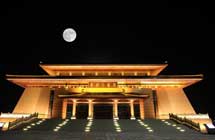中国拟在月球背面种花养蚕 打造“微型生态圈”
|
China hopes to create a 'mini biosphere' on the dark side of the Moon, with flowers and silkworms sustaining each other as they grow on the lifeless lunar surface. The uNPRecedented plan to create life in outer space is the most intriguing part of China's lunar probe mission later this year, and could be a major boost for dreams that humans will one day live on the Moon. The insects, plants, potato seeds and arabidopsis—a small flowering plant belonging to the mustard family - will be taken to the Moon on board the Chang'e-4 lander and rover in December.
They will be placed in an 18cm tall bucket-like tin made from special aluminum alloy materials, together with water, a nutrient solution, and a small camera and data transmission system. A small tube will direct natural sunlight into the tin to help the plants and potato seeds grow. Although known figuratively as the "dark side" as it is unseen, the far side of the moon receives almost equal sunlight to the near side. The next stage of the mini-ecological system will see the plants emitting oxygen, which will feed the silkworms hatching from their cocoons. The silkworms will create carbon dioxide and produce waste that will allow the plants to grow, Chinese scientists say. "Our experiment might help accumulate knowledge for building a lunar base and long-term residence on the Moon," Professor Liu Hanlong, chief director of the experiment and vice president of Chongqing University, told Xinhua news agency. Astronauts have previously grown plants in the International Space Station, while Chinese "taikonauts" grew rice and arabidopsis in China's Tiangong-2 space lab. But those experiments were conducted in low-Earth orbit at an altitude of about 400 kilometres. "The environment on the Moon, 380,000 kilometres from the Earth, is more complicated," Xinhua said. The moon's gravity is only about 16 percent of the earth's - which is considered a major barrier to the success of the project. The development of living organisms would also be at risk from the harsh climate on the Moon, where temperatures range from lower than -100 °C to higher than 100 °C. Xie Gengxin, chief designer of the experiment, said: "We have to keep the temperature in the 'mini biosphere' within a range from 1 degree to 30 degrees, and properly control the humidity and nutrition. "We will use a tube to direct the natural light on the surface of Moon into the tin to make the plants grow." Potato and arabidopsis were chosen for the experiment because they grow quickly and can be easily observed by scientists. "And potato could become a major source of food for future space travellers," said Professor Liu. China's plans to become the first country to softly land a probe to the dark side of the moon will represent the country's latest milestone in space. In 2003, it became the third country to put a man in space with its own rocket after the former Soviet Union and the United States. Ten years later it became the third country to carry out a lunar rover mission. China aims to land a man on the moon sometime after 2030, most observers say, while last year an official said that it would “not take long” before Beijing approved a manned lunar project. |









